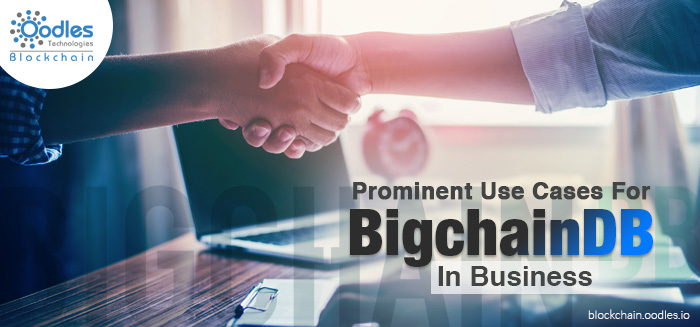-
What's BigchainDB?
Designed to amalgamate the best of two worlds: the "traditional" blockchain sphere and the "traditional" distributed ledger (database), BigchainBD rather than enhancing the blockchain technology starts with a big data distributed decentralized database. Further, it adds blockchain characteristics- immutability, decentralized control, and the transfer of digital assets.
Benefits of BigchainDB
Decentralized Control:
It has no single point of failure and no single point of control. Due to decentralized control via a federation of voting nodes, it forms a P2P network.
Write and Run Query:
Powered by MongoDB, one can write and run any MongoDB query and search the elements of all stored transactions, metadata, assets, and blocks.
Immutability:
It's more than only tamper-resistant, once you store data, it can't be changed or altered.
Innate Support of Multi-assets:
It works on native currency, thus, any asset, currency or token can be issued.
Byzantine Fault Tolerant (BFT):
Even though if one-third of the nodes in the network are experiencing arbitrary faults, the rest of the network still comes to the consensus process on the next block.
Provides Low Latency:
It takes about a second to come to the consensus process on a new block, making transaction finality happen extremely fast.
It's Customizable:
It allows developing your own private network with custom assets, permissions, transactions, and transparency.
It's Open Source:
It's open-source to the community. It means everyone can use it to develop their own applications on top of it.
Roll Out Public or Private Networks:
Another advantage is it allows to roll out your own private or public networks for specific industry use cases.
Prominent Use Cases For BIgchainDB In Business
BigchainDb is mainly used by developers and organizations looking for a queryable ledger that has blockchain elements such as immutability, decentralization and the potential to treat tangible as well as intangible things stored in the database as an asset. Whether it's bits, bytes or atoms, any real-world blockchain application would require performance, which can be achieved through using BigchainDB.
BigchainDB In Supply Chain:
For instance, in a typical supply chain scenario, various entities/parties work together and exchange information with each other. Essentially, this information is related to the processes/operations of tracking goods and products being manufactured until they reach the logical end-point of the cycle of the supply chain (retailers/end-consumers). Two prime obstacles that occur during the collaboration of these parties/entities in a supply chain scenario are the management and the security of the information that's being shared. Eventually, it gives birth to several silos of data, which becomes hard to manage later. That's where the blockchain technology comes into play. In general, it can help in organizing this data in a distributed or shared system to simplify and improve the overall management of information. Due to its potential characteristics like immutability and tamper-resistance, Blockchain offers a concrete layer of trust to the collaborating entities in a supply chain; they can trust data even if they don't trust each other. Although other decentralized systems and blockchain can efficiently organize data in a shared system, they might not able to provide high throughput and query capabilities, which are necessary for a supply chain scenario. And that's where BigchainDB comes into play. In a supply chain scenario, a BigchainDB based private blockchain can help organize data in a decentralized system. BichainDB Private Blockchains enable the users to query the data for reports and do calculations on the go.
Manage Intellectual Property Rights Efficiently:
Blockchain technology seems to be the panacea for problems related to IP rights management and provenance. The technology has several benefits to offer to the artists as well by offering the immutability to their claims. It can also be used to prove the ownership of the IP rights. For this, initially, Bitcoin blockchain was created but its throughput became a bottleneck soon. That's why BigchainDB was envisioned. BigchainDB 2.0 can handle high throughput than other blockchains and hence, makes for an excellent choice for use cases related to IP rights.
Identity Management:
Identity management is a crucial part when it comes to micro-managing user-related data and information. Now it's more than necessary to ensure the protection of the identity of a human or even a machine. It needs to be self-sovereign and hack-proof. We also need to make sure that the systems handling the identity management are capable of effectively handling the high scale of it. That when BigchainDB plays its part, handling identity management related issues without involving any hassle.
Data Governance:
In a typical data governance scenario, numerous organizations and parties/entities collaborate on setting up standard processes and directives. Today, data governance deals with the lack of collaboration and trust issues. Also, there are no incentives for the participant to attract them to collaborate on issues related to data governance. BigchainDB proves to be a suitable alternative for managing data governance. It provides an incentive-based, easy-to-integrate platform. The approach should be to model data governance feedbacks, topics and economic incentives as the assets of BigchainDB assets. By modeling a data governance system as a collection of BigchainDB assets, all participants can be given incentives for collaboration.
Closing Remarks:
Generally, BigchainDB can be integrated into almost every scenario where there's a requirement for immutability and tamper-proof storage of data assets with the capability to allow for search and query along with high throughput. BigchainDB can also be utilized by organizations or group of people who want to share their database for business purposes, even when they don't trust each other.

Our Offices
INDIA
Emaar Digital Greens, Sector 61,
Gurugram, Haryana
122011.
Welldone Tech Park,
Sector 48, Sohna road,
Gurugram, Haryana
122018.















